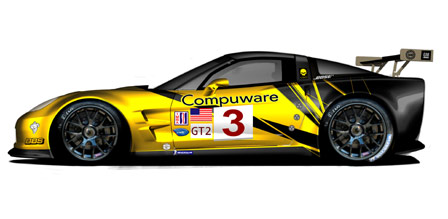
As we learn more about the GT2 Corvette C6.R race cars, it’s becoming more apparent that Corvette Racing’s unsung hero is the technological know-how that allowed the team to go from concept approval in September 2008 to race-ready in August 2009. In this next press release from GM Racing, we get a look at the technical insights on the new production GT Race Car and what the engineers faced in designing the next-generation Corvette C6.R.
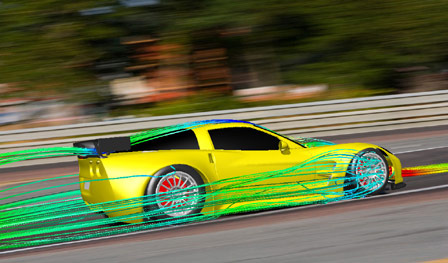
Airflow through the front brakes and radiator is shown in this CFD graphic. Brake cooling air exits the front wheels and travels along the side of the car while radiator cooling air moves over the roof and under the wing (Richard Prince/GM Racing Photo).
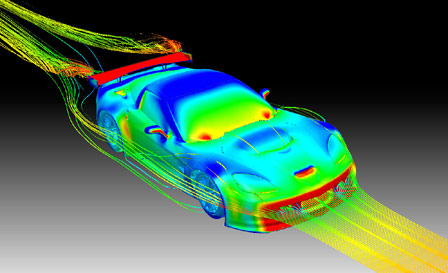
This CFD graphic shows areas of high and low pressure on the GT2 Corvette C6.R body. Red on the front fascia, sideview mirrors and wing indicates high pressure; blue on the roof and fenders indicates areas of low pressure (Richard Prince/GM Racing Photo).
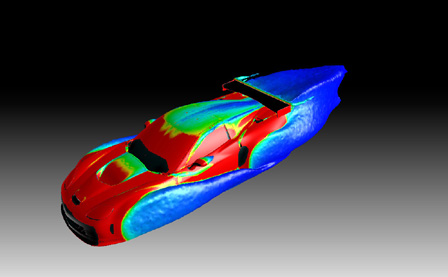
This CFD study visualizes surface vortices and the resulting turbulence as the GT2 Corvette C6.R moves through the air. Airflow around the wheel openings and the wing is highly turbulent as indicated by the blue wakes, while the airflow over the roof is relatively undisturbed (Richard Prince/GM Racing Photo).
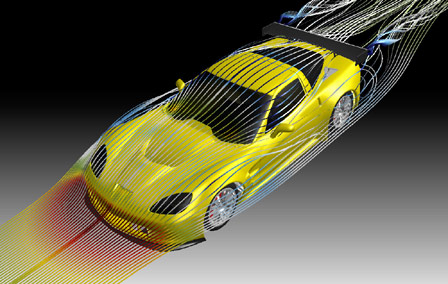
The streamlines in this CFD (computational fluid dynamics) study illustrate the airflow around the body of the GT2 version of the Corvette C6.R (Richard Prince/GM Racing Photo).
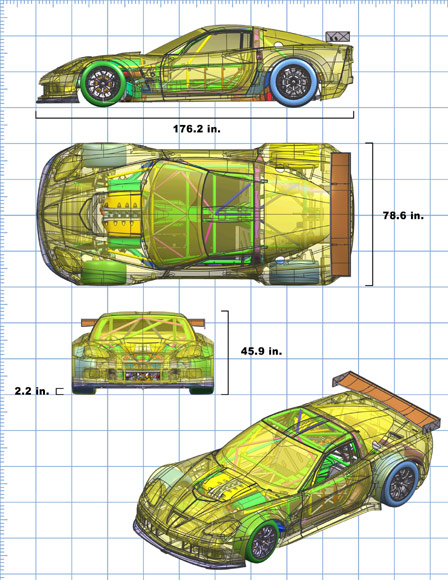
This CAD (computer-aided design) illustration shows the overall layout of the GT2 Corvette C6.R’s components, with a GM small-block V8 engine mounted behind the centerline of the front wheels and a 6-speed sequential-shift transaxle between the rear wheels (Richard Prince/GM Racing Photo).
Corvette Racing White Paper: Inside the Next-Generation Corvette C6.R
Technical Insights on Corvette Racing’s Production-Based GT Race Car
DETROIT – Corvette Racing is moving toward the future of production-based sports car racing with the introduction of the next-generation Corvette C6.R race car. With international regulations converging around a single GT class, Corvette Racing will continue its motorsports heritage by racing against manufacturers and marques that Corvette competes with in the marketplace. This white paper highlights the design and development of the latest version of the Corvette C6.R and spotlights its technical features.
The second-generation Corvette C6.R is the successor to the championship-winning C5-R and C6.R race cars that have dominated the GTS and GT1 categories in the last decade. Corvette Racing retired its GT1 Corvette C6.R race cars following the team’s sixth victory in the 24 Hours of Le Mans on June 14, 2009. Corvette Racing will compete in the GT2 category of the American Le Mans Series for the remainder of the 2009 season, starting at the series’ sixth round at the Mid-Ohio Sports Car Course on August 8. During this transition, Corvette Racing will test and develop the next-generation C6.R race cars in anticipation of a unified GT class in 2010.
PRODUCTION-BASED PLATFORM
The next-generation Corvette C6.R race car has strong ties to its production counterpart. Under the leadership of the Automobile Club de l’Ouest (ACO) and the Fédération Internationale de l’Automobile (FIA), the Corvette Racing program’s key objectives include reducing costs, encouraging independent teams to purchase and race Corvettes, and reinforcing the relevance of racing technology to production vehicles.
Doug Fehan, Corvette Racing program manager: “Key elements in the decision to move to the new class were the strong visual and mechanical similarities between production Corvettes and the racing Corvettes, along with the increased production content in the GT2 race car. Corvette is a technological development platform for GM, and this move provided the opportunity to design and develop technology and components that would be relevant to future Corvettes and other GM vehicles. This connection drew the race team even closer to the production Corvette group and gave us new areas to explore together.”
Tadge Juechter, Corvette chief engineer: “Behind the scenes, the race team and the production car team have grown closer together, finding numerous ways to support each other and to make both cars better. Most automotive companies give lip service to claims like ‘racing improves the breed’ or ‘race on Sunday, sell on Monday’. For team Corvette, it is a daily reality. It is now impossible to imagine one team without the other.
“The move to GT2 only strengthens the trajectory we were on. The Corvette race and production teams will grow even closer together, and so will the cars. Having more commonality will increase the synergies in the development process. Facing our market rivals on the track will be a thrill for race fans and strong evidence that potential sports car customers should buy a Corvette. I am confident that endurance racing in GT2 will be an enormous benefit to our customers and to General Motors.”
GT2 HOMOLOGATION
The regulations require the Corvette C6.R race car to be based on a production vehicle. This designated vehicle then determines the specifications for homologation (acceptance and approval) of the racing version. The GT1 version of the Corvette C6.R was homologated on the production Corvette Z06. A crucial step in the design of the GT2 version of the Corvette C6.R was the selection of the Corvette ZR1 as the basis for its homologation.
Doug Louth, Corvette Racing engineering director: “Early in the design process we had to decide whether to use the base Corvette coupe with its steel chassis and narrow bodywork or the Corvette Z06 or ZR1 models, which have an aluminum chassis and wider bodywork. We ran a number of simulations and CFD studies comparing the wide versus narrow bodies and looked at various track width options. In the end, the data favored the wider car, even at a high-speed, low-drag track like Le Mans. Fortunately that aligned with the marketing objective to showcase the ZR1 as the Corvette that offers the highest level of performance.”
ZR1 ROOTS
The Corvette ZR1 is an American supercar that has won accolades for its extraordinary performance and exceptional value. While the GT rules preclude the use of the ZR1’s supercharged 638-horsepower LS9 small-block V8 engine, they do permit the race car to take full advantage of the ZR1’s aerodynamic enhancements that were developed in concert with Corvette Racing. The production Corvette ZR1 has wide carbon fiber front fenders with dual vents, a full-width rear spoiler, and a front fascia splitter – features designed to enhance high-speed stability and driver control.
Fehan: “The ZR1 uses a different splitter and a different rear spoiler than other Corvette models, and both of these enhance the Corvette C6.R’s aerodynamic performance. The ZR1 was conceived as a 200 mph road car and it was developed with input from Corvette Racing. Race team engineers worked with Corvette chief engineer Tom Wallace and his successor, Tadge Juechter, providing track data and CFD simulations that had been done on the race cars. Working together they were able to develop an effective and balanced aero package for the Corvette ZR1.
“The Corvette C6.R race car is now virtually identical to the Corvette ZR1 street car in appearance. The rules in GT1 allowed us to section and widen the fenders, but the GT2 rules require production-type fenders with simple flares to accommodate wider tires. Consequently the race car looks like a production car, because it fundamentally is one.”
ALUMINUM FRAME
The GT2 version of the Corvette C6.R is built on the same aluminum frame that underpins production Corvette Z06 and ZR1 models. In contrast, the GT1 race cars used steel frames from the Corvette coupe and convertible. Both aluminum and steel production Corvette frames are hydroformed, a process that uses high-pressure hydraulics to form complex shapes.
Fehan: “The race team had been exploring the aluminum frame for several years. The traditional methods of connecting a steel roll cage to an aluminum frame simply didn’t provide a level of safety that met GM Racing’s stringent standards. Consequently we have developed a proprietary installation method that is consistent with GM’s commitment to safety.”
Louth: “The race car chassis retains all of the elements in the production chassis structure – the windshield frame, the hoop around the rear of the passenger compartment, the door hinge pillars, the drivetrain tunnel, the firewall, the floor pan – they’re all there. In the GT1 class, these components could be removed, modified, or trimmed down, but the ACO and FIA rules for GT2 require that we maintain all of the primary production chassis structure in the race car.”
AERODYNAMICS
Differences in the GT1 and GT2 rules account for many of the changes in the Corvette C6.R’s aerodynamic package. The front fender louvers used in GT1 are not allowed in GT2. The chord width of the rear wing was reduced 25 percent, from 400mm to 300mm. The diffuser now starts at the back of the rear wheel opening rather than at the centerline of the rear axle; strakes and sidewalls are not permitted, so the GT2 diffuser is a flat panel while the GT1 diffuser was effectively a tunnel. The production-based ZR1 splitter extends 25mm, in contrast to the 80mm splitter allowed under the GT1 rules.
Louth: “CFD (computational fluid dynamics) was the primary tool used to develop the aero package in the short time that was available. During the validation phase, the team performed high-speed straight-line tests and conducted a full-scale rolling-road wind tunnel test. We have been through all of our aerodynamic tuning options at the track, and the baseline aero settings meet all of the performance targets.
“As we developed the race car aero package, we went through a number of reviews with the Corvette design group. They were very interested not only in what we were doing, but what they might take away for future Corvettes. There was a two-way exchange of concepts and ideas, and it proved to be a very rewarding relationship.”
Fehan: “The production splitter we are using in GT2 does not require a massive rear wing to produce aerodynamic balance, and consequently there is less total downforce. This actually makes the car more predictable over a wide range of speeds. The GT1 version had tremendous downforce, but the downforce was directly proportional to speed. In slow corners the car behaved differently than it did in fast corners, so the drivers had to adjust for the amount of grip they would have at various speeds. With the GT2 aero package, the car behaves very predictably in low, medium, and high-speed corners. Consequently the drivers report that the new Corvette C6.R a very good race car.”
SUSPENSION AND STEERING
The GT1 Corvette C6.Rs were equipped with carbon brake rotors, while GT2 regulations require ferrous (steel) brake discs. The Corvette race car’s wheel and tire dimensions are the same in both classes, but the GT2 version uses aluminum rather than magnesium rims.
Fehan: “The production ZR1 has ceramic brakes, which we would love to use in the race cars. However, the series requires steel brakes to help contain cost.”
Louth: “Early in the GT1 program we ran steel brakes in the 24-hour Daytona race, so we did have some previous experience. We also received excellent information from our brake and pad suppliers, and input from GM’s other racing programs. Initially there was some concern about the switch from carbon to steel brakes, but in the end the braking performance is actually very good. Steel brakes don’t produce the absolute stopping power of carbon brakes, but the braking performance – repeatability, consistency and driver feel – hit our targets in fairly short order.
“The GT2 race car has a production steering column, with a fully adjustable steering wheel – a real convenience with as many as three drivers per car. The rack-and-pinion steering is also production.”
SAFETY AND ERGONOMICS
Safety is the No. 1 priority at GM Racing. The GM Racing safety research and development program was founded in 1992, and it expanded from its initial focus on open-wheel cars to encompass stock car racing, sports car racing, drag racing and off-road racing. The racing safety program is built on the foundation of GM’s world-class safety research and testing programs for passenger vehicles.
Louth: “Our chief concern was the aluminum chassis and the attachment of the steel safety cage. Analysis and physical testing of structural components suggest that this car is the safest GT car on the track. We carried over the energy-absorbing panels in the doors, the door bar structure, the crush structure, the right-side safety net, and other safety features from the GT1 Corvettes. These are not mandatory items, but we chose to add those components at a considerable cost and weight disadvantage because driver safety is our top priority.
“Driver ergonomics was not a big challenge because the cockpit layout and packaging is very similar to the GT1 C6.R. The production-based air conditioning system was carried over from the previous version because it had proven to be very effective, although improvements were made in the ducting.”
TELEMETRY
The GT1 Corvettes were instrumented with nearly 100 sensors that monitored everything from engine oil temperature to tire pressures. Much of this information was transmitted in real time from the car to the pit, where engineers and technicians could watch for developing problems. The GT2 rules do not allow telemetry, so this data must now be downloaded during pit stops.
Louth: “Without telemetry, the driver has more responsibility to catch minor problems before they become major problems. Obviously a driver is extremely busy during a race, so he may be less effective at monitoring data and seeing warnings than someone in the pits who is focused on a computer screen. Since we cannot use telemetry in GT2, we are working on our dashboard alarms to alert the driver when there is a problem without distracting him when operating conditions are normal during a race.
“The ban on telemetry is due to cost considerations. However, the downside of not having telemetry is that when something does go wrong, it can result in a catastrophic failure that costs much more. A blown engine, a seized transmission, or a punctured tire that causes a crash and injures a driver are failures that can often be avoided or stopped short with telemetry.”
CONSTRUCTION AND TESTING
The GT2-spec Corvettes were designed, built and tested on a compressed schedule. The program was approved and announced in September 2008, and construction of the first chassis began in early December. The first track test was conducted at Road Atlanta on April 8-9, followed by single-car tests in Elkhart Lake, Wis., and Sebring, Fla.
Fehan: “Testing has gone very well, and that’s not really surprising with all of the lessons we learned in GT1. In the initial track test, we rolled the car out of the trailer and ran for two straight days with absolutely no problems. It was incredible, and everyone was understandably very excited.
“Corvette Racing has the advantage of sophisticated computer models for aero and chassis development, and we have a library of suspension setups. In the first two days of testing, we hit all of the predictions dead on, which validated both our software and our design.
“In the limited testing we’ve done so far, we’ve been very impressed with the car’s durability, reliability and performance. We’ll continue to focus on those three factors in the upcoming races. We view the rest of this year as a development cycle, and we believe that our experience as a team in preparation, race strategy, and pit stop execution should allow us to be competitive even if there is a slight performance disparity.”
Gary Pratt, Corvette Racing team manager: “We’re not running for a championship this year, so the testing we’d prefer to do in private we do in the public eye. We’re looking at the next five races as preparation for 2010. Our goal is to learn as much as we can.
“In a perfect world we’d have the rest of this year to test and then come out with new cars at the start of next season, but we felt we just needed to get out there and race for the Corvette customers and fans. We think we’ll be competitive, but there are many good cars and teams in GT2. We know it will be a challenge, and we’re looking forward to it.”
The GT2 version of the Corvette C6.R will make its debut at the Acura Sports Car Challenge at the Mid-Ohio Sports Car Course in Lexington, Ohio. The two-hour, 45-minute race is scheduled to start at 3 p.m. EDT on Saturday, August 8. ABC will televise the race tape-delayed at 2:30 p.m. EDT on Sunday, August 9.

Bondurant School of High Performance Driving
Source:
A New Era: Introducing Corvette Racing’s GT2 ZR1 C6.R
[VIDEO] Corvette Racing’s Doug Fehan Talks about the ZR1-Based GT2 Corvette C6.R
[VIDEO] Corvette Racing’s Doug Fehan Talks about Le Mans, Green Challenge and Jake
[VIDEO] Corvette Racing: Gavin and Beretta Win Final ALMS GT1 Race at Long Beach
Corvette Racing: Pratt & Miller GT2 Corvette Spied at Road Atlanta
Corvette Racing: GT2 Corvette C6.R to Wear ZR1 Bodyy
Technorati Tags:
Corvette |
Vette |
Chevrolet |
Chevy |
GM |
2009 |
GT2 |
ALMS |
C6R |
Racing |
Jake |
-



